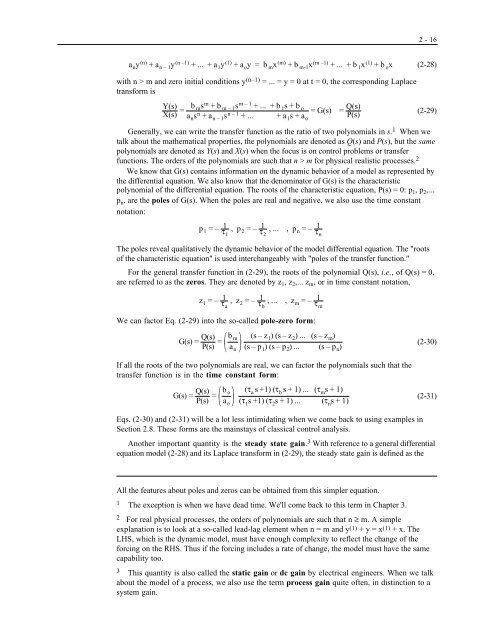Chemical Process Control a First Course with Matlab
Chemical Process Control a First Course with Matlab
Chemical Process Control a First Course with Matlab
Create successful ePaper yourself
Turn your PDF publications into a flip-book with our unique Google optimized e-Paper software.
2 - 16<br />
a n y (n) +a n – 1 y (n –1) + ... + a 1 y (1) +a o y=b m x (m) +b m-1 x (m –1) + ... + b 1 x (1) +b o x (2-28)<br />
<strong>with</strong> n > m and zero initial conditions y (n–1) = ... = y = 0 at t = 0, the corresponding Laplace<br />
transform is<br />
Y(s)<br />
X(s) = b ms m +b m – 1 s m – 1 + ... + b 1 s+b o<br />
a n s n +a n – 1 s n – 1 =G(s) = Q(s)<br />
+ ... + a 1 s+a o<br />
P(s)<br />
(2-29)<br />
Generally, we can write the transfer function as the ratio of two polynomials in s. 1 When we<br />
talk about the mathematical properties, the polynomials are denoted as Q(s) and P(s), but the same<br />
polynomials are denoted as Y(s) and X(s) when the focus is on control problems or transfer<br />
functions. The orders of the polynomials are such that n > m for physical realistic processes. 2<br />
We know that G(s) contains information on the dynamic behavior of a model as represented by<br />
the differential equation. We also know that the denominator of G(s) is the characteristic<br />
polynomial of the differential equation. The roots of the characteristic equation, P(s) = 0: p 1 , p 2 ,...<br />
p n , are the poles of G(s). When the poles are real and negative, we also use the time constant<br />
notation:<br />
p 1 = – 1 τ 1<br />
,p 2 = – 1 τ 2<br />
, ...<br />
, p n = – 1 τ n<br />
The poles reveal qualitatively the dynamic behavior of the model differential equation. The "roots<br />
of the characteristic equation" is used interchangeably <strong>with</strong> "poles of the transfer function."<br />
For the general transfer function in (2-29), the roots of the polynomial Q(s), i.e., of Q(s) = 0,<br />
are referred to as the zeros. They are denoted by z 1 , z 2 ,... z m , or in time constant notation,<br />
z 1 = – 1 τ a<br />
,z 2 = – 1 τ b<br />
, ... , z m = – 1 τ m<br />
We can factor Eq. (2-29) into the so-called pole-zero form:<br />
G(s) = Q(s)<br />
P(s) = b m<br />
a n<br />
(s – z 1 )(s– z 2 ) ... (s – z m )<br />
(s – p 1 )(s– p 2 ) ... (s – p n )<br />
If all the roots of the two polynomials are real, we can factor the polynomials such that the<br />
transfer function is in the time constant form:<br />
G(s) = Q(s)<br />
P(s) = b o<br />
a o<br />
(τ a<br />
s +1) (τ b<br />
s + 1) ... (τ m<br />
s+1)<br />
(τ 1<br />
s +1) (τ 2<br />
s + 1) ... (τ n<br />
s+1)<br />
(2-30)<br />
(2-31)<br />
Eqs. (2-30) and (2-31) will be a lot less intimidating when we come back to using examples in<br />
Section 2.8. These forms are the mainstays of classical control analysis.<br />
Another important quantity is the steady state gain. 3 With reference to a general differential<br />
equation model (2-28) and its Laplace transform in (2-29), the steady state gain is defined as the<br />
All the features about poles and zeros can be obtained from this simpler equation.<br />
1 The exception is when we have dead time. We'll come back to this term in Chapter 3.<br />
2 For real physical processes, the orders of polynomials are such that n ≥ m. A simple<br />
explanation is to look at a so-called lead-lag element when n = m and y (1) + y = x (1) + x. The<br />
LHS, which is the dynamic model, must have enough complexity to reflect the change of the<br />
forcing on the RHS. Thus if the forcing includes a rate of change, the model must have the same<br />
capability too.<br />
3 This quantity is also called the static gain or dc gain by electrical engineers. When we talk<br />
about the model of a process, we also use the term process gain quite often, in distinction to a<br />
system gain.



